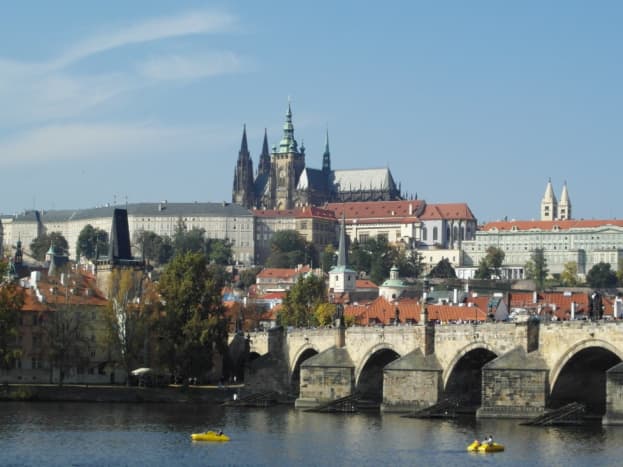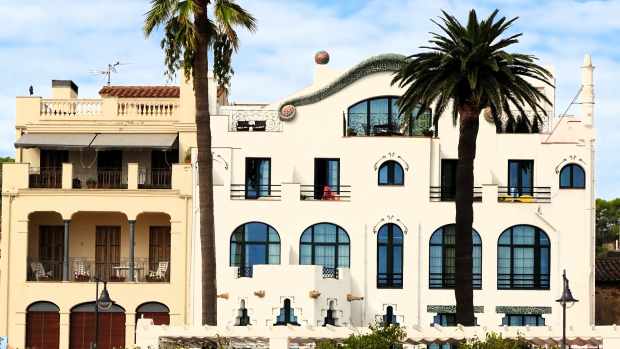Prague: Exploring the Castle and Hradcany
A Must-See in the Capital of the Czech Republic
Tourists in Prague are spoilt for choice by the vast number of interesting places to see in the city. No visit to the fascinating Czech capital would be complete without venturing up the hill to inspect Prague Castle and the immediate area around it, Hradcany, which dominate the Prague skyline.
Founded in the 9th century by Prince Borivoj, Prague Castle is located high above the River Vltava on its west bank. Within the castle walls, there was a palace, three churches, and a monastery. Around 1320 the town of Hradcany was founded in the outer bailey. The castle has been remodeled and rebuilt many times. It has been the seat of the president of the Republic since 1918.
Several of Prague's main tourist attractions are located in this area.
Getting There
There are several routes to Prague Castle. The most popular one follows the tourist trail from the Old Town, over Charles Bridge, and up through Prague's Little Town (Mala Strana) to the main palace gates at the top of the hill. This is the Royal Route, referring to the coronation procession, taken by Bohemian kings and queens from the Royal Court (now the site of the Municipal House in Prague Old Town) to Prague Castle.
The route we took was a walk from Malostranska metro station, up Stare Zamecke schody, to enter the eastern end of the castle complex.
An alternative option is to take the tram, which runs along Marianske Hradby, and approach the castle from the north.
Whichever way you get there, the castle area is slightly remote from public transport and involves walking up a hill, unless you can get a taxi to drop you a little nearer.
Walking has its advantages, as you can pause en route and take in the view of the city which unfolds below the castle hill.
Whichever way you go, be prepared to queue at the security checkpoints before entering the castle compound.



The Sights
These are the top sights that we saw while exploring Prague Castle and Hradcany, followed by a few we missed and also some refreshment opportunities.
- Prague Castle
- St. Vitus Cathedral
- The Old Royal Palace
- St. George's Basilica
- Golden Lane
- The South Gardens
- Hradcany Square
- Strahov Monastery
1. Prague Castle
Prague Castle was not quite what I expected. Coming from the UK, I am used to seeing ancient fortifications, set upon a hill, and dating back many years. Many of them have fallen into disuse, or at least have had little done in terms of modifications for hundreds of years. Prague Castle differs in that it has evolved over hundreds of years, with the addition and development of royal palaces to cover a significant area. It is said to be the largest coherent castle complex in the world. It covers an area of almost 70,000 square meters.
Prague Castle is a UNESCO world heritage site. Within its walls are the remains of Romanesque-style buildings from the 10th century, Gothic modifications from the 14th century, Renaissance-style rebuilding after a fire in the 16th century, and extensive renovations (1918-1938). In recent years there has been a program of ongoing repairs.
There are three courtyards in Prague Castle. The first and smallest courtyard is by the main entrance. The second courtyard is overlooked by the Picture Gallery and the President's Office. This contains the Church of the Holy Rood. The third courtyard is dominated by St. Vitus Cathedral. Beyond lies St. George's Basilica and smaller streets. A line of royal palaces stretches along the frontage, overlooking the River Vltava and the city of Prague.
There are ticket offices located in information centers in the second and third courtyards. The changing of the guard takes place on the hour at the main gate. We found this a crowded and overrated affair. It is better to wait and get photos of the guards at a quieter time.











Short Tour vs. Long Tour
I was unprepared for the bewildering amount of choices in the ticket office at Prague Castle. It is worth considering the options before you go and, unlike us, having a good idea of which ticket you want to buy. I found the ticket office experience pressurized. It was crowded and not easy to make a quick decision based on the information we gleaned from the notice boards.
Ticket Options
Here are the ticket options when touring Prague Castle.
Circuit A (Long Tour)
St. Vitus Cathedral, Old Royal Palace, Exhibition 'The Story of Prague Castle', St. George's Basilica, Golden Lane with Daliborka Tower, Rosenberg Palace.
Circuit B (Short Tour)
St. Vitus Cathedral, Old Royal Palace, St. George's Basilica, Golden Lane with Daliborka Tower.
Circuit C
The exhibition "The Treasure of St. Vitus Cathedral", Prague Castle Picture Gallery.
Optional Separate Tickets
- The exhibition "The Story of Prague Castle"
- The exhibition "The Treasure of St. Vitus Cathedral"
- Prague Castle Picture Gallery
- Great South Tower with a View Gallery
- The Powder Tower
After some deliberation, we selected circuit B. This worked well, as it gave us a flavor of what Prague Castle had to offer, without overloading us with too much to take in.
2. St. Vitus Cathedral
Towering over the castle area and visible from many parts of Prague, St. Vitus Cathedral cannot be missed. The outside is just as impressive when viewed close up as it is from a distance. I used to think the Sagrada Familia in Barcelona, which is still not finished, had taken a while to build, but St. Vitus Cathedral puts it in the shade. Work began in 1344 and the completed cathedral was finally consecrated in 1929.
The Outside
For free you can wander around the outside of the cathedral. Facing the main entrance of the castle area, the west front, between the twin spires, is now the main entrance to the cathedral. If you walk round to the bell tower, you will find the golden portal and the original main entrance, which is still used on special occasions. Stop and admire the mosaic of The Last Judgement above it by 14th-century craftsmen from Venice.
If you continue walking, you come to the impressive flying buttresses, which support the vaulted interior and are richly decorated. The one drawback is that close up you struggle to get the whole cathedral in a single camera shot. At least you can appreciate some of the detail and the craftsmanship that has gone into it over hundreds of years.
The Inside
The long tour and the short tour tickets for the castle compound both include entrance to St. Vitus Cathedral. As you enter through the west portal, you will be struck by the impressive height of the nave. The west end is the most recent part, having been built in the 19th-20th centuries. You will notice stained glass dating from the 20th century. As you wander further, you come to the main area, dating back to the 14th century and you will pass many side chapels.
At the far end, the chancel, dating from 1372, has an impressive high vault. Below, in the center of the choir, lies the marble Imperial Mausoleum from the 16th century, where the Habsburg Ferdinand I is buried with his wife and son, Maximilian II.
Most visitors head for St. Wenceslas Chapel, by the south door. The Czech Republic's patron saint, Wenceslas, or Sv Vaclav, was killed by Boleslav the Cruel, his pagan brother. After later repenting and converting, the story goes that Boleslav moved Wenceslas's remains to this spot. The walls of the chapel are gilded and inlaid with many semi-precious stones. There are 14th-century frescoes of the Passion and 16th-century paintings depicting the tragedy of Wenceslas.
Another sight not to miss is the Tomb of St. John of Nepomuk, located in a chapel towards the top of the chancel. After being arrested and thrown off Charles Bridge by order of Wenceslas IV in 1393, Jan Nepomucky, vicar-general of the Archdiocese of Prague, achieved cult status in the eyes of the Jesuits in the years following his drowning. He was canonized in 1729 and the elaborate solid silver tomb dates from 1736.
The Bit We Missed
Whether it was the angina-inducing 287 steps or that it was closed during our visit, I now look back with regret that we did not climb up the south tower of the cathedral. The views from there over the castle compound and the city of Prague below must be stunning. There is an additional charge for access to the south tower.
Tip: Prague Cathedral is closed to visitors when services are held there. If you find this happens to you, it might be worth checking out the other sights, before returning to see the cathedral later. It is worth noting that castle tickets are valid for two days, should you wish to return.











3. The Old Royal Palace
This collection of royal apartments, in the middle of a stretch of the castle overlooking the South Gardens and Prague below, is also on both tour tickets. The earliest part of the construction (the cellars of the present building) dates back to around 1135. Subsequently, other layers have been built on top. The top floor contains the Vladislav Hall, a Gothic rib-vaulted structure, where early Bohemian kings were elected and where presidents since 1918 have been sworn into office.
The Bohemian Chancellery is the location of a defenestration. In 1618, 100 Protestant nobles threw two Catholic governors out of the window. Both survived the 15-meter drop, by landing in a dung heap. Their survival was attributed by Catholics to the intervention of angels.
Tip: While you are walking around the palace, stop and take a look through the windows at the view of the South Gardens and Prague below.


4. St. George's Basilica
The rusty red facade of the Basilica of Sv Jiri (to give it its Czech name) is slightly misleading, as it dates back to the 17th-century Baroque style. The basilica actually pre-dates the cathedral, as it was founded in the 10th century. The interior has been restored to re-create a Romanesque building that replaced the original church in 1173. Throughout the Middle Ages, the basilica and the adjoining convent were at the heart of the castle complex. Admission is included on the short tour ticket.








